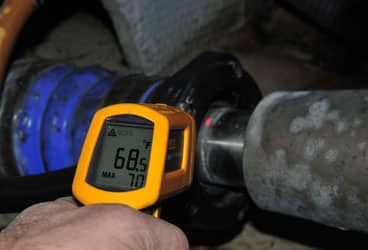
Infrared pyrometer
While there’s no substitute for experience and training, tools often do make the mechanic or electrician. And when it comes to diagnosis, troubleshooting, and analyzing systems and equipment, the ability to quickly and accurately measure temperature is very useful. Until a few years ago, this required placing the sensing end of a contact thermometer against or, in the case of a liquid, into whatever was being measured. That often proved difficult, and accurate readings were spotty. But today, affordable ($50 to $90) noncontact or infrared pyrometers make this an easier and more accurate undertaking. Most units are shaped like guns and are switched on with a trigger. A laser helps the user aim the pyrometer at the object whose temperature is to be measured.
The variety of onboard uses for infrared pyrometers is nearly limitless: The device can measure such moving objects as fan belts and propeller shafts as well as live electrical circuits, including those used with shore power, inverters, and generators.
You can use an infrared pyrometer to analyze the temperature and cooling water flow to a stuffing box and make adjustments. Typically, stuffing-box temperatures should be no greater than 30 F above the ambient water temperature; if it’s warmer, the box is either overtightened or lacks sufficient water flow. Using the pyrometer to scan such energized DC circuits as batteries, battery connections, cables, switches, circuit breakers, and fuses can quickly identify areas of high resistance or impending faults. Batteries within the same bank should, while being charged, operate at roughly the same temperature. If one or more are significantly higher, it could mean that they’re either packed together too tightly—there should be at minimum a .25-inch gap separating batteries—or an internal short has developed.
Alternators and oil pans are two components whose temperatures are often unregistered until there’s a failure. Ideally, an alternator’s outer case and pulley should operate at no more than 200 F. (The stator may operate at 250 F.) If it’s hotter, it’s being overworked and undercooled, which may indicate that you need an alternator with a higher duty rating. Crankcase lubricating oil has an ideal temperature range, typically between 160 F and 220 F. When operating oil is too cool, sludge and varnish are formed; when the oil is too hot, it tends to suffer from thermal degradation and loss of viscosity. By measuring at the vertical center of the oil pan, you can determine if your engine’s oil is in the sweet spot. The hose temperature in a “wet” exhaust system shouldn’t exceed 200 F at any rpm; ideally, it will be under 150 F. Use your infrared pyrometer to check yours at various cruising speeds to determine if your exhaust elbow is clogged.
As useful as infrared pyrometers are, they’re often misused. The most common fault involves the unit’s field of view. Users often believe that the area being measured is only as large as the targeting laser dot. In fact, the pyrometer measures a cone-shaped area, and the temperatures of all objects within the cone’s footprint are averaged. Because the footprint grows as the pyrometer is moved farther from the object being measured, it’s best to get as close as possible to the object in question, of course within the bounds of safety.
Infrared-pyrometer readings can also be compromised by especially shiny surfaces, such as highly polished metal. Applying nonreflective tape such as masking tape to these surfaces enables the pyrometer to yield more accurate readings.
Steve D’Antonio offers services for boat owners and buyers through Steve D’Antonio Marine Consulting.
For more maintenance tips, click here.








